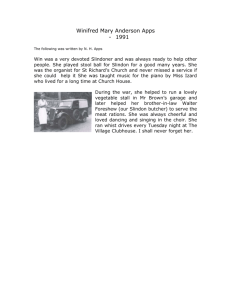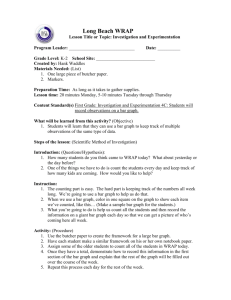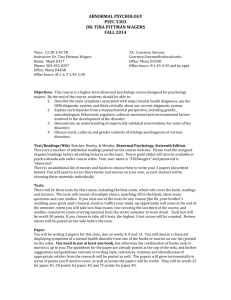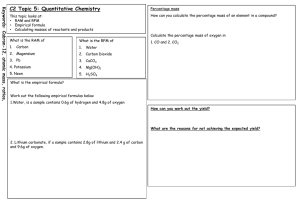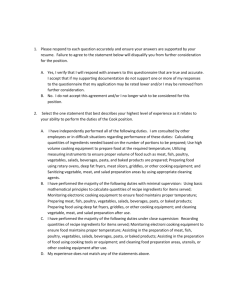Portions
advertisement
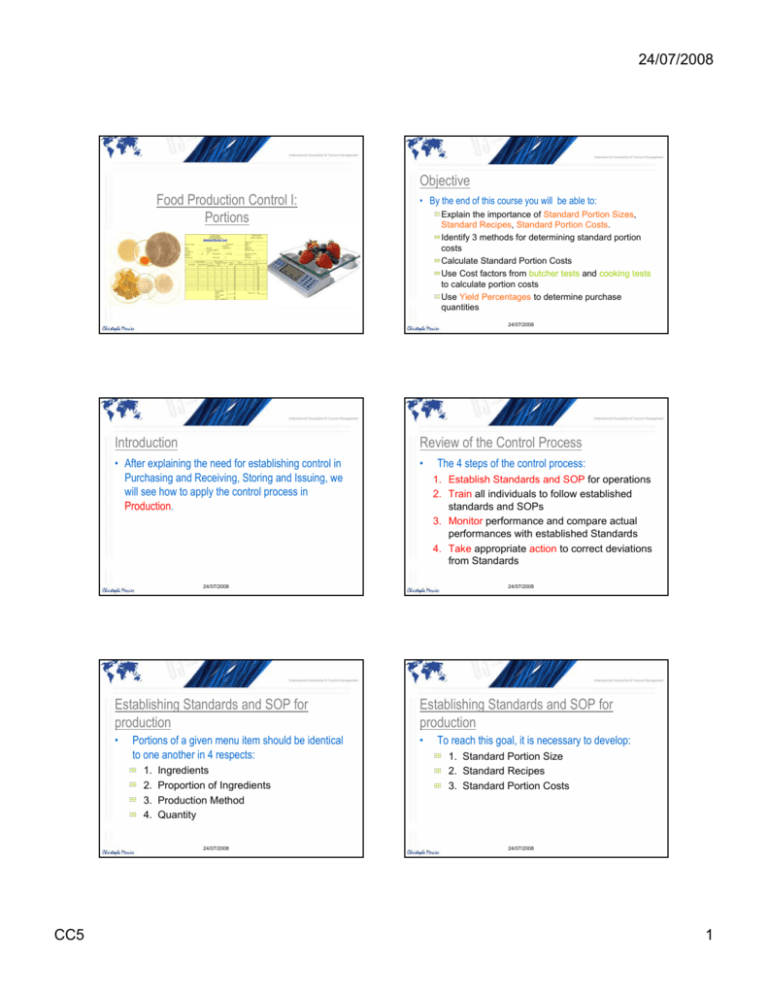
24/07/2008 Objective Food Production Control I: Portions • By the end of this course you will be able to: Explain the importance of Standard Portion Sizes, Standard Recipes, Standard Portion Costs. Identify 3 methods for determining standard portion costs Calculate Standard Portion Costs Use Cost factors from butcher tests and cooking tests to calculate portion costs Use Yield Percentages to determine purchase quantities 24/07/2008 Introduction Review of the Control Process • After explaining the need for establishing control in Purchasing and Receiving, Storing and Issuing, we will see how to apply the control process in Production. • 24/07/2008 24/07/2008 Establishing Standards and SOP for production Establishing Standards and SOP for production • • Portions of a given menu item should be identical to one another in 4 respects: 1. 2. 3. 4. Ingredients Proportion of Ingredients Production Method Quantity 24/07/2008 CC5 The 4 steps of the control process: 1. Establish Standards and SOP for operations 2. Train all individuals to follow established standards and SOPs 3. Monitor performance and compare actual performances with established Standards 4. Take appropriate action to correct deviations from Standards To reach this goal, it is necessary to develop: 1. Standard Portion Size 2. Standard Recipes 3. Standard Portion Costs 24/07/2008 1 24/07/2008 1. Standard Portion Size Devices available to help standardize portions • Every item on a menu can be quantified in one of the 3 ways: Weight (most frequently grams or ounces) • GVB serves a 12-ounce portion of strip steak Volume (in ounces or milliliters/ centiliters) • Mostly for liquids ( a bowl of soup: 5 or 8 ounces Count (sausage/ eggs, chops…) • Shrimps may be purchased at 16 or 20 per Pound • Pies may be sold by cut sizes (1 pie serves 6 or 8) 24/07/2008 24/07/2008 Advantages of Standardized portions: 2. Standard Recipes • Reduce customer discontent (and loss of sales) • Eliminate discussions between kitchen staff and dining room staff (fighting over size is waste of time) • Eliminate excessive cost linked to oversizing/ over pouring • A list of the ingredients and the quantities of those ingredients needed to produce a particular item along with a process to follow Sample Conversions 24/07/2008 24/07/2008 3. Standard Portion Costs Calculating Standard Portion Costs • A standard portion cost can be calculated for every item on every menu provided that the ingredients, proportions, production methods and portion sizes have been standardized as previously discussed. • There are several methods for calculating Standard portion costs Formula Standard portion cost = Purchase price per unit Number of portion per unit For example if a restaurant serves a 2-eggs standard portion for breakfast, what is the cost per portion? (a 30 dozen case costs $ 41.40) 24/07/2008 CC5 24/07/2008 2 24/07/2008 Calculating Standard Portion Costs Butcher Test • • Recipe Detail and Cost Card Sample (fill in the blanks) When meat, fish and poultry are purchased as wholesale cuts, the purchaser pays the same price for each and every pound of the item purchased even though after butchering the resulting parts may have entirely different values. For example if a cut of meat is composed of fat, usable meat and bones. We need to know to cost of usable meat 24/07/2008 Illustration of the Butcher Test 24/07/2008 Butcher Test • Calculating Butcher Cost Sample of Butcher Test Card Weight of a part = Ratio to total weight Weight of whole To calculate the percentage of usable meat: 4 lbs. 4 oz. (4.25 lbs) = .4722 or 47% 9 lbs. 0 oz. (9.00 lbs) 24/07/2008 Butcher Test 24/07/2008 Butcher Test • Calculating Butcher Cost To calculate the Cost per Usable Pound: Total Value of usable meat ($) Weight of usable meat (lb.) To calculate the Cost per Portion: • Cost Factors A simple mean to calculate usable pound costs and portion costs whenever market prices change so that it is not necessary to complete a new butcher test form each time Portion size (oz.) x Cost per usable oz.= Portion Cost 24/07/2008 CC5 24/07/2008 3 24/07/2008 Calculating Cost Factors • Cost factor per lb Using the Cost Factors • Useful in case of a New Dealer Price per lb: Cost per Usable lb = Cost Factor per lb Purchase Price per lb • Cost factor per portion Cost Factor per lb x New Dealer Price per lb =New Cost of Usable lb. Cost Factor per Portion x New Dealer Price per lb =New Cost of Portion Portion Cost = Cost Factor per Portion Purchase price per lb 24/07/2008 Cooking Loss Test Yield percentages • The primary purpose for the cooking loss test is the same as that for the butcher test: determining standard portion cost. • The cooking loss test is used for those items that cannot be portioned until after cooking is complete. • The yield factor is defined as the percentage of a whole purchase unit of meat, poultry or fish that is available for portioning after any required in-house processing has been completed • The Yield percentage is calculated by dividing the portionable weight by the original weight of the purchase unit before processing Sample of a cooking loss test 24/07/2008 24/07/2008 Yield Percentage Yield Percentages • The result (a percentage) is the ratio to total weight also called Salable Weight. • The yield is used to calculate quantities to buy Quantity =Number of portions x Portion Size (decimal) Yield Percentage • This equation can be used to find the number of portions a specific quantity can yield and so forth • Books can provide standardized yields for most food, therefore, some managers choose not to perform yield tests in house: 24/07/2008 CC5 24/07/2008 Advantages of using standardized yields: • Save labor costs • Help to make decisions on “how much to buy” Disadvantages of using standardized yields • Impossible to compare vendor prices and quality • Less accurate than when it’s done in-house 24/07/2008 4 24/07/2008 Chapter Essentials • We have seen… The application of the Control process in controlling portions in Food Production The standardization of ingredients portions and production methods and sizes How to determine portion costs in using • Formula/ recipe details and cost cards, Butcher Test and cooking loss tests and cost factors The calculations of “how much to buy” using Yield percentages. 24/07/2008 CC5 5


